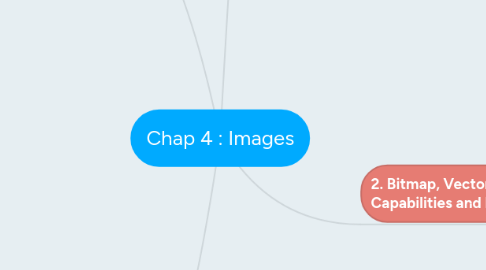
1. 3. The use of colors and palettes in multimedia
1.1. 3. Dithering
1.1.1. process color value of each pixel is changed to the closest matching color value in the target palette.
1.1.2. This is done using a mathematical algorithm.
1.2. 1. Understanding natural light color
1.2.1. EXPLAIN:
1.2.1.1. Light comes from an atom: where an electron passes from a higher >> lower energy lVl.
1.2.1.2. Each atom produces uniquely specific colors.
1.2.1.3. Color - frequency of a light wave within the narrow band of the electromagnetic spectrum to which the human eye responds.
1.2.2. TYPES:
1.2.2.1. 1. Additive color
1.2.2.1.1. - additive color method: a color is created by combining colored light sources in 3 primary colors - red, green, and blue (RGB).
1.2.2.1.2. -TV and computer monitors use this method.
1.2.2.2. 2. Subtractive color
1.2.2.2.1. subtractive color method: - color is created by combining colored media EG: paints or ink.
1.2.2.2.2. colored media absorb (or subtract): some parts of the color spectrum of light and reflect the others back to the eye.
1.2.2.2.3. Subtractive color: - process used to create color in printing.
1.2.2.2.4. The printed page consists of tiny halftone dots of three primary colors: 1. cyan, 2. magenta, and 3. yellow (CMY).
1.2.2.3. 3. Color models
1.2.2.3.1. Models used to specify color in computer terms are:
1.3. 2. Color palettes
1.3.1. mathematical tables that define the color of pixels displayed on the screen.
1.3.2. “color lookup tables,” or CLUTs, on the Macintosh.
1.3.3. The most common palettes are 1-, 4-, 8-, 16-, and 24-bits deep.
2. 4. Various Image file types used in multimedia
2.1. 1. Macintosh formats
2.1.1. the most commonly used format is PICT.
2.1.2. PICT - complicated and versatile format developed by Apple.
2.1.3. Macintosh ( image application) - import / export PICT files.
2.1.4. PICT file, both vector-drawn objects and bitmaps can reside side by side.
2.2. 2. Windows formats
2.2.1. 1. The most commonly used image file format on Windows : DIB = BMP.
2.2.1.1. DIB stands for device-independent bitmaps.
2.2.2. 2. Bitmap formats : used most often by Windows developers are:
2.2.2.1. BMP - A Windows bitmap file
2.2.2.2. TIFF - Extensively used in DTP packages
2.2.2.3. PCX - Used by MS-DOS paint software
2.3. 3. Cross-platform formats
2.3.1. Most commonly used format on the Web
2.3.1.1. EG: JPEG, GIF, and PNG –
2.3.2. Manages multimedia content
2.3.2.1. EG: Adobe Portable Document Format (PDF)
2.3.3. Proprietary formats used by applications
2.3.3.1. EG: PSD, AI, CDR, DXF –
2.3.4. Standard for transferring CAD drawings
2.3.4.1. EG: Initial Graphics Exchange Standard (IGS/ IGES)
2.3.5. Standard for transferring 3-D files
2.3.5.1. EG: COLLADA 3D
2.3.6. XML text-based formats used by Google for mapping
2.3.6.1. EG: KML (Keyhole Markup Language) and KMZ (a zipped package of KML files and images)
2.4. 4. Image File Compression
2.4.1. Lossy formats
2.4.1.1. EG: JPEG files
2.4.1.2. EG: PSD, PSP, GIF, PNG, BMP, TIFF, and RAW
3. 1. Before You Start to creation of images in multimedia, you should:
3.1. 1. Plan your approach
3.1.1. Outline project and graphics ideas first – Make a flowcharts and storyboards
3.2. 2. Organize the available tools
3.2.1. authoring systems = the tools can create the graphic objects of multimedia directly on screen.
3.3. 3. Configure computer workspace
3.3.1. Have multiple monitors, if possible, for lots of screen real estate (viewing area)
4. 2. Bitmap, Vector and 3-D images – Capabilities and Limitation of all three
4.1. Making Still Images
4.1.1. - most important element of multimedia project. - small or large, or even full screen. - be colored, placed at random on the screen, evenly geometric, or oddly shaped.
4.1.2. Still images are generated in two ways: 1. Bitmaps (raster) = painting program 2. Vector-drawn graphics =drawing program
4.1.2.1. 1. Bitmaps: - derived from the words “bit,” - simplest element in digital world, an electronic digit ( on or off) / ( black or white) / ( true (1) or false (0).) - simple matrix of the tiny dots that form an image & displayed on a screen or printed. - data matrix that describes the characteristics of all the pixels making up an image. - varying bit and color depths. - made up of individual dots or picture elements known as pixels or pels.
4.1.2.1.1. 1. An image format suited for creation of:
4.1.2.1.2. 2. Where do bitmaps come from?
4.1.2.1.3. 3. Capturing and editing images
4.1.2.1.4. 4. Image editing programs enable the user to:
4.1.2.2. 2. Vector-drawn graphics
4.1.2.2.1. 1. Applications of vector-drawn object
4.1.2.2.2. 2. How vector-drawn images work
4.1.2.2.3. 3. Vector-drawn images versus bitmaps
4.1.2.3. 3. Vector-drawn images VS bitmaps
4.1.2.3.1. Vector images
4.1.2.3.2. Bitmaps
4.1.2.4. 4. 3-D drawing and rendering
4.1.2.4.1. 1. 3-D animation tools
4.1.2.4.2. 2. Features of a 3-D application
4.1.2.4.3. 3. Panoramas
